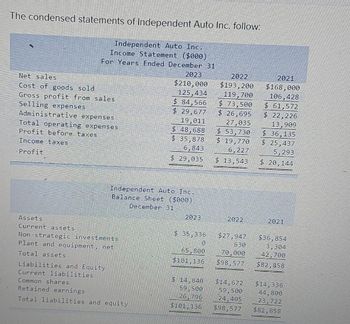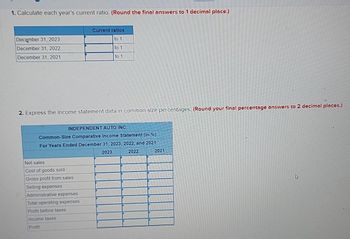
FINANCIAL ACCOUNTING
10th Edition
ISBN: 9781259964947
Author: Libby
Publisher: MCG
expand_more
expand_more
format_list_bulleted
Concept explainers
Topic Video
Question
Please do not give solution in image format thanku

Transcribed Image Text:The condensed statements of Independent Auto Inc. follow:
Independent Auto Inc.
Income Statement ($000)
For Years Ended December 31
Net sales
Cost of goods sold
Gross profit from sales
Selling expenses
Administrative expenses
Total operating expenses
Profit before taxes
Income taxes
Profit
Assets
Current assets
Non-strategic investments
Plant and equipment, net
Total assets
2023
$210,000
125,434
Liabilities and Equity
Current liabilities
Common shares
Retained earnings
Total liabilities and equity
$ 84,566
$ 29,677
19,011
Independent Auto Inc.
Balance Sheet $000)
December 31
$ 48,688
$ 35,878
6,843
$ 29,035
2023
$ 35,336
0
65,800
$101, 136
$ 14,840
59 500
26, 796
$101.136
2022
$193,200
119,700
$ 73,500
$ 26,695
27,035
$ 53, 730
$ 19,770
6,227
$ 13.543
2022
$27,947
630
70,000
$98,577
$14,672
59,500
24,405
$98,577
2021
$168,000
106,428
$ 61,572
$22,226
13,909
$ 36,135
$25,437
5,293
$ 20,144
2021
$36,854
3,304
42,700
$82,858
$14,336
44,800
23,722
$82,858

Transcribed Image Text:1. Calculate each year's current ratio. (Round the final answers to 1 decimal place.)
December 31, 2023
December 31, 2022
December 31, 2021
2. Express the income statement data in common-size percentages. (Round your final percentage answers to 2 decimal places.)
Current ratios
to 1
to 1
to 1
INDEPENDENT AUTO INC.
Common-Size Comparative Income Statement (in %)
For Years Ended December 31, 2023, 2022, and 2021
2023
2022
Net sales
Cost of goods sold
Gross profit from sales
Selling expenses
Administrative expenses
Total operating expenses
Profit before taxes
Income taxes
Profit
2021
Expert Solution
This question has been solved!
Explore an expertly crafted, step-by-step solution for a thorough understanding of key concepts.
Step by stepSolved in 4 steps

Knowledge Booster
Learn more about
Need a deep-dive on the concept behind this application? Look no further. Learn more about this topic, accounting and related others by exploring similar questions and additional content below.Similar questions
- can you please write your solution out and not use excel.arrow_forwardCan you please enter the information clearly without so many spaces? The information is hard to read.arrow_forwardSelect the letter of the item below that best matches the definitions that follow. a. Data Files CD ________ b. Lists ________ c. Forms ________ d. Registers ________ e. Reports and graphs ________ f. Restoring a backup ________ g. Icon bar ________ h. Home page ________ i. Backing up a file ________ 1. One click access to QuickBooks Accountant Centers and Home page. 2. The process of rebuilding a backup file to a full QuickBooks Accountant file ready for additional input. 3. Electronic representations of paper documents used to record business activities such as customer invoices, vendor bills, and checks. 4. A big-picture approach of how your essential business tasks fit together organized by logical groups such as customers, vendors, and employees. 5. Groups of names such as customers, vendors, employees, items, and accounts. 6. Contains backups of all the practice files needed for chapter work and completion of assignments. 7. The process of creating a copy of a…arrow_forward
arrow_back_ios
SEE MORE QUESTIONS
arrow_forward_ios
Recommended textbooks for you

 AccountingAccountingISBN:9781337272094Author:WARREN, Carl S., Reeve, James M., Duchac, Jonathan E.Publisher:Cengage Learning,
AccountingAccountingISBN:9781337272094Author:WARREN, Carl S., Reeve, James M., Duchac, Jonathan E.Publisher:Cengage Learning, Accounting Information SystemsAccountingISBN:9781337619202Author:Hall, James A.Publisher:Cengage Learning,
Accounting Information SystemsAccountingISBN:9781337619202Author:Hall, James A.Publisher:Cengage Learning, Horngren's Cost Accounting: A Managerial Emphasis...AccountingISBN:9780134475585Author:Srikant M. Datar, Madhav V. RajanPublisher:PEARSON
Horngren's Cost Accounting: A Managerial Emphasis...AccountingISBN:9780134475585Author:Srikant M. Datar, Madhav V. RajanPublisher:PEARSON Intermediate AccountingAccountingISBN:9781259722660Author:J. David Spiceland, Mark W. Nelson, Wayne M ThomasPublisher:McGraw-Hill Education
Intermediate AccountingAccountingISBN:9781259722660Author:J. David Spiceland, Mark W. Nelson, Wayne M ThomasPublisher:McGraw-Hill Education Financial and Managerial AccountingAccountingISBN:9781259726705Author:John J Wild, Ken W. Shaw, Barbara Chiappetta Fundamental Accounting PrinciplesPublisher:McGraw-Hill Education
Financial and Managerial AccountingAccountingISBN:9781259726705Author:John J Wild, Ken W. Shaw, Barbara Chiappetta Fundamental Accounting PrinciplesPublisher:McGraw-Hill Education


Accounting
Accounting
ISBN:9781337272094
Author:WARREN, Carl S., Reeve, James M., Duchac, Jonathan E.
Publisher:Cengage Learning,

Accounting Information Systems
Accounting
ISBN:9781337619202
Author:Hall, James A.
Publisher:Cengage Learning,

Horngren's Cost Accounting: A Managerial Emphasis...
Accounting
ISBN:9780134475585
Author:Srikant M. Datar, Madhav V. Rajan
Publisher:PEARSON

Intermediate Accounting
Accounting
ISBN:9781259722660
Author:J. David Spiceland, Mark W. Nelson, Wayne M Thomas
Publisher:McGraw-Hill Education

Financial and Managerial Accounting
Accounting
ISBN:9781259726705
Author:John J Wild, Ken W. Shaw, Barbara Chiappetta Fundamental Accounting Principles
Publisher:McGraw-Hill Education